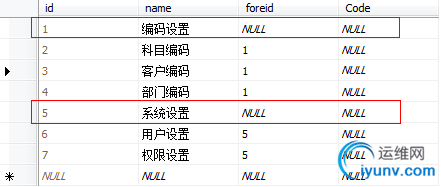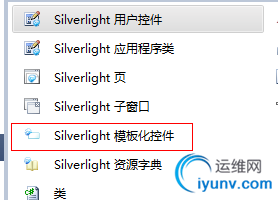|
|
经过上一篇的分析,现在开始动手!
首先来看一下. 我们的菜单他的表现形式是如何的.
比如说我们现在有一个数据库叫 lonix_gls_2 有一个表menu (菜单)
id 为主键, fore_id 为上级id , name 为菜单名 , Code为菜单所对面的xaml文件名
菜单为树形结构.数据如下, 红色为 主菜单


 T-SQL 代码
T-SQL 代码
1 SET ANSI_NULLS ON
2 GO
3 SET QUOTED_IDENTIFIER ON
4 GO
5 IF NOT EXISTS (SELECT * FROM sys.objects WHERE object_id = OBJECT_ID(N'[dbo].[menu]') AND type in (N'U'))
6 BEGIN
7 CREATE TABLE [dbo].[menu](
8 [id] [int] IDENTITY(1,1) NOT NULL,
9 [name] [nvarchar](10) NULL,
10 [foreid] [int] NULL,
11 PRIMARY KEY CLUSTERED
12 (
13 [id] ASC
14 )WITH (IGNORE_DUP_KEY = OFF) ON [PRIMARY]
15 ) ON [PRIMARY]
16 END
我们用RIA SERVICE 所查出来的代码结构应该如下
1 new List
2 {
3 new TestModel {
4 Name = "编码设置",
5 Children = new List {
6 new TestModel { Name = "00101", Code="Test" } ,
7 new TestModel { Name = "00102", Code="Test1" } ,
8 new TestModel { Name = "00103" }
9 }
10 },
11 new TestModel {
12 Name = "系统设置",
13 Children = new List {
14 new TestModel { Name = "00201" }
15 }
16 },
17 };
以上为测试数据..
打开VS 新建三个模版控件!

新建的类默认从 Control 继承. 我们需要手动将其改为从 ItemsControl继承..
总共新建
Desktop(继承ItemsControl[主菜单容器]) 以作用于包含任意项的 DesktopGroup
DesktopGroup(继承ItemsControl[分组菜单容器]) 以作用于包含任意项的 DesktopItem
DesktopItem(继承ContentControl[子主菜单项])
一. Desktop 主菜单容器
1. 使desktop 中的子项 横向自动布局, 因此我们将他的ItemsPanel 设为StackPanle
2. 使循环绑定子项
3. 容器的布局
代码如下:
1
2
3
4
5
6
7
8
9
10
11
12
13
14
15
16
17
18
19
20
21
22
23
24
25
26
27
28
29
30
local 命名空间为 当前项目
xmlns:local="clr-namespace:当前项目"
common 命名空间为
xmlns:common="clr-namespace:System.Windows;assembly=System.Windows.Controls"
Desktop 数据绑循环为 DesktopGroup
二. DesktopGroup子菜单容器
同Desktop 基本相同
1
2
3
4
5
6
7
8
9
10
11
12
13
14
15
16
17
18
19
20
21
22
23
24
25
28
29
30
31
32
33
34
35
36
37
DesktopGroup 数据绑定循环为 DesktopItem
DesktopItem相比这二个之下可能有点繁琐,因此放在下一篇来制作 |
|